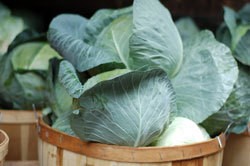
Select freshly picked, solid heads that feel weighty for their size and have fresh leaves and good color. Heads should be tightly attached to their stems and not starting to separate. If harvesting your own cabbage, leave it in the ground as late in the fall as possible before the first frost. Frozen cabbage will be wilted when thawed, but can still be used for cooking.
Trim coarse outer leaves from head. Cut into medium to coarse shreds or thin wedges, or separate the head into individual leaves.
Cabbage can be frozen directly without being blanched, but for cabbage intended for sours and casseroles requiring cooked cabbage, water-blanch convenient sized wedges for 3 to 4 minutes or steam blanch them for 4 to 6 minutes. Whole leaves or shredded cabbage can be water-blanched for 1 1/2 minutes. Cool promptly and drain.
Suitable packaging for freezing includes freezer-grade plastic bags, rigid plastic containers or glass containers and heavy duty aluminum foil.
10 to 12 months at 0ºF.
Thaw coleslaw in the refrigerator. Add frozen cabbage directly to dishes.
Cabbage can be brined as sauerkraut or made into coleslaw or relishes and frozen. Whole leaves can be frozen unblanched for use as wrappers for baking or stuffing, and used immediately after thawing. Cabbages should not be frozen whole. Store whole heads, roots intact, by hanging them upside down in a root cellar. Keeping the outer leaves intact will keep the inner leaves from drying out.
Do not wash until use. Store whole cabbages in perforated plastic bags for 4 to 8 weeks. Store coleslaw in an airtight container for 3 days. Sauerkraut can be stored in a non-metal, airtight container for up to 1 week.

Add your voice! Click below to comment. ThriftyFun is powered by your wisdom!
can I freeze cabbage to make sauerkraut at a later time? If so, How??
Add your voice! Click below to comment. ThriftyFun is powered by your wisdom!